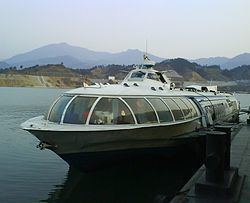Postal code 445000 Area 24,000 km² Area code 0718 | Time zone China Standard (UTC+8) Website enshi.gov.cn | |
 | ||
Country People's Republic of China Weather 14°C, Wind E at 3 km/h, 68% Humidity | ||
Tours tv com enshi tujia and miao autonomous prefecture
Enshi Tujia and Miao Autonomous Prefecture (Chinese: 恩施土家族苗族自治州; pinyin: Ēnshī Tǔjiāzú Miáozú Zìzhìzhōu) is located in the mountainous southwestern corner of Hubei province, People's Republic of China. It forms Hubei's southwestern "panhandle", bordering on Hunan in the south and Chongqing Municipality in the west and northwest. The Yangtze River crosses the prefecture's northeastern corner in Badong County.
Contents
- Tours tv com enshi tujia and miao autonomous prefecture
- Administration
- Geography
- Climate
- Demographics
- Transportation
- Economy
- Imperial
- Republican
- References
Administration
There are two county-level cities:
There are six counties:
Geography
Enshi Prefecture is located in the mountainous belt separating Hubei's Jianghan Plain from the Sichuan Basin.
There are karst phenomena in the region. The most famous of them is perhaps the Tenglong Cave near Lichuan. A 290-meter deep karst sinkhole, located near the village of Luoquanyan (锣圈岩村) in Xuan'en County, is described as possessing its own unique ecosystem.
The so-called Enshi Grand Canyon (恩施大峡谷) is also a well-known scenic area.
Climate
Enshi City has a monsoon-influenced humid subtropical climate (Köppen Cfa), with short, cool winters, hot, humid summers, and high humidity year-round. The monthly 24-hour average temperature ranges from 5.0 °C (41.0 °F) in January to 26.7 °C (80.1 °F) in August, while the annual mean is 16.18 °C (61.1 °F). More than two-thirds of the annual precipitation of 1,470 millimetres (58 in) occurs from May to September. With monthly percent possible sunshine ranging from 12% in January to 50% in August, the prefecture seat receives only 1,212 hours of bright sunshine annually; winter is especially overcast while July thru September is the sunniest period of the year.
Demographics
The total area is 24,000 square kilometres (9,300 sq mi), and the population is 3,800,000. 52.6% of the population belong to the Tujia and Miao nationalities. Enshi is the only autonomous prefecture in Hubei province.
Enshi is also the only part of Hubei which has been included in the Chinese government's Western exploration programme and over the next 5–10 years they will put 50 billion RMB into its development.
Transportation
The prefecture has only a small amount of Yangtze River frontage, but Badong, in the prefecture's northeast, has a Yangtze River port.
The Qing River in the central part of the prefecture, with its cascade of reservoirs, is an important waterway as well.
Due to the mountainous terrain, until recently the prefecture had no railways, and even the highways were of doubtful quality.
The Yichang−Wanzhou Railway, completed in December 2010, crosses the prefecture from east to west, providing a more direct connection between Hubei and Sichuan than was previously available. In addition, the Chongqing−Lichuan Railway from the Lichuan Railway Station on the Yiwan line connects the cities. A single line now connects Enshi with Beijing and Wuhan as well as many additional cities. The train between Beijing and Enshi takes approximately 24 hours and includes many stops along the way.
The G42 Shanghai–Chengdu Expressway, routed along the same Yichang-Wanzhou corridor, is under construction. The Sidu River Bridge on that road has become the world's highest bridge.
Economy
The soil in Enshi is rich in selenium. Enshi is known as the "seleninum capital of China" and is the world's sole independent seleninum deposit. Seleninum Square in the city is named after this rare element.
The countryside has a diverse range of flora and fauna, including many Chinese herbs. Much of the mountain landscape is covered in virgin forest and is home to pangolins.
Enshi locals are especially proud of their potato crops and consider the potato and tea crops to be the region's agricultural specialties.
Enshi Prefecture possesses significant hydroelectric resources. Among major hydroelectric dams already completed, or under construction, within the prefecture are:
Imperial
"Endless green mountains to walk on, endless clear water going away" (by a poet of the Tang dynasty)
Republican
Republic of China's Hubei provincial government was relocated to Enshi during the 1937-45 resistance war (against Japanese invasion and occupation).
The Roman Catholic Church had the Diocese of Shinan on the territory of today's Enshi Prefecture.
